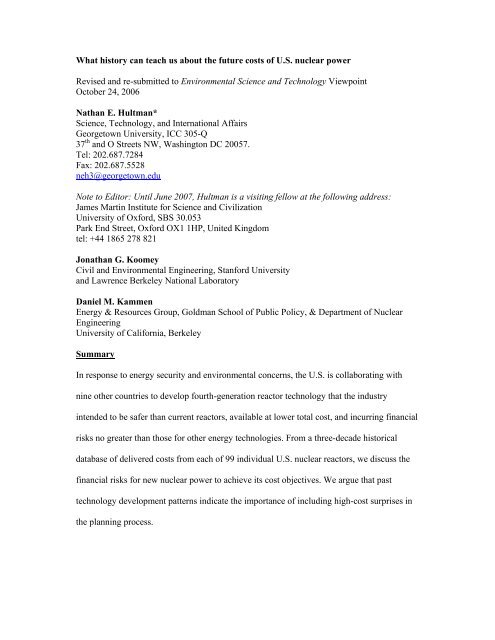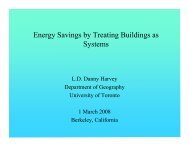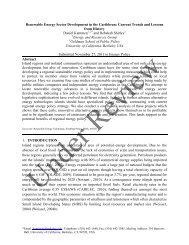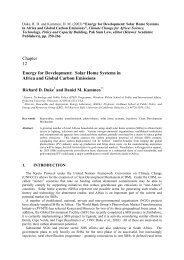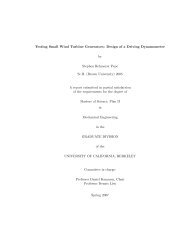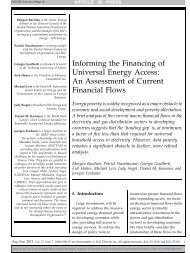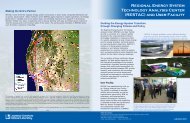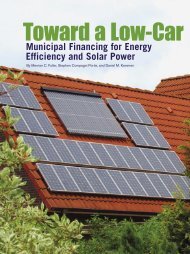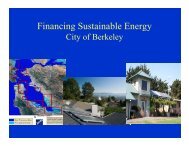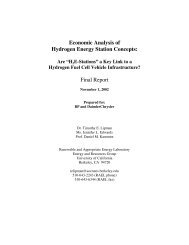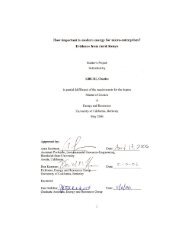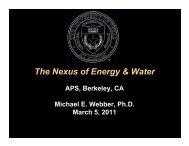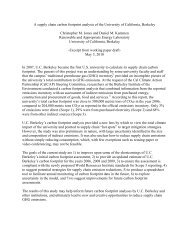What history can teach us about the future costs of U.S. nuclear ...
What history can teach us about the future costs of U.S. nuclear ...
What history can teach us about the future costs of U.S. nuclear ...
- No tags were found...
You also want an ePaper? Increase the reach of your titles
YUMPU automatically turns print PDFs into web optimized ePapers that Google loves.
<strong>What</strong> <strong>history</strong> <strong>can</strong> <strong>teach</strong> <strong>us</strong> <strong>about</strong> <strong>the</strong> <strong>future</strong> <strong>costs</strong> <strong>of</strong> U.S. <strong>nuclear</strong> power<strong>the</strong> reactors surveyed delivered total <strong>costs</strong> above $0.08 per kWh and 5% were above$0.12/kWh. Importantly, while many estimates for <strong>the</strong> <strong>costs</strong> <strong>of</strong> new <strong>nuclear</strong> technologyanticipate a normally or log-normally distributed cost distribution, this high-cost cl<strong>us</strong>terexceeds signifi<strong>can</strong>tly <strong>the</strong> prices for new plants that traditional financial analysis wouldpredict (21). Financial risk is <strong>of</strong>ten defined as <strong>the</strong> possibility <strong>of</strong> surprise, and historical record<strong>of</strong> <strong>nuclear</strong> power clearly demonstrates this possibility.Nuclear power <strong>costs</strong> in <strong>the</strong> United States have undergone a well-chronicled trajectory <strong>of</strong>increasing capital <strong>costs</strong> and operating <strong>costs</strong>, followed by dramatic improvements inoperational efficiency and reliability (17,22-25). From <strong>the</strong> start <strong>of</strong> commercial <strong>nuclear</strong> reactorconstruction in mid-1960s through <strong>the</strong> 1980s, capital <strong>costs</strong> (dollars per kilowatt <strong>of</strong> capacity)for building <strong>nuclear</strong> reactors escalated dramatically. While unit <strong>costs</strong> for technology <strong>us</strong>uallydecrease with volume <strong>of</strong> production due to scale factors and technological learning (26-28),<strong>the</strong> case <strong>of</strong> <strong>nuclear</strong> has been seen largely as an exception that reflects idiosyncrasies <strong>of</strong> <strong>the</strong>regulatory environment as public opposition grew, regulations were tightened, andconstruction times increased (15,29,30).Beca<strong>us</strong>e <strong>of</strong> <strong>the</strong> low variable <strong>costs</strong> <strong>of</strong> <strong>nuclear</strong> power, this escalation in capital <strong>costs</strong> had alarge impact on delivered electricity <strong>costs</strong>. In fact, for <strong>the</strong> 99 reactors for which capital costdata are publicly available, this factor explains 91.6% <strong>of</strong> <strong>the</strong> observed variance in totallifetime levelized <strong>costs</strong> (p < 0.01). Never<strong>the</strong>less, operational learning, perhaps spurred byimproved economic incentives in <strong>the</strong> ind<strong>us</strong>try (25,31), has contributed to signifi<strong>can</strong>tdecreases in marginal electricity production <strong>costs</strong>. The Gen-IV process hopes to avoid costoverruns by integrating standardized reactor designs with tighter regulatory approval5
<strong>What</strong> <strong>history</strong> <strong>can</strong> <strong>teach</strong> <strong>us</strong> <strong>about</strong> <strong>the</strong> <strong>future</strong> <strong>costs</strong> <strong>of</strong> U.S. <strong>nuclear</strong> powertimelines. It remains to be seen if this goal <strong>can</strong> be achieved without constructing manyreactors <strong>of</strong> each type.After <strong>the</strong> accident at Three Mile Island (1979), <strong>the</strong> ind<strong>us</strong>try was subjected to intenseregulatory scrutiny and evaluation. As a result, <strong>the</strong> overall fleet capacity factor—<strong>the</strong> netgeneration for all reactors in <strong>the</strong> set divided by <strong>the</strong> maximum possible generation <strong>of</strong> allreactors in <strong>the</strong> set—dropped precipito<strong>us</strong>ly and reached its nadir in 1982 at 52.9%. During <strong>the</strong>period 2000-2004, <strong>the</strong> 69 reactors operational by 1982 had improved <strong>the</strong>ir overall capacityfactor to 87.4%. This increase, attributable to improvements in utilization rates and decreasesin service downtime (32), is equivalent to an additional 16.3 GW <strong>of</strong> generation j<strong>us</strong>t fromthose reactors existing in 1982—equivalent to <strong>the</strong> addition <strong>of</strong> approximately 15 new <strong>nuclear</strong>reactors. A similar calculation shows that such operational improvements, applied to allinstallations, not j<strong>us</strong>t <strong>the</strong> ones existing in 1982, “added” <strong>the</strong> equivalent <strong>of</strong> 25 new reactors.Moreover, capacity factors improved over all age classes, suggesting that <strong>the</strong> improvementswere due primarily to operational learning ra<strong>the</strong>r than to technological differences.The historical experience <strong>of</strong> <strong>nuclear</strong> power in <strong>the</strong> U.S. presents not only specific failures thatmight be addressed through policy, but also suggests that new, complex, and culturallysensitive technologies risk surprises that skew <strong>the</strong> distribution <strong>of</strong> <strong>costs</strong> beyond what might beexpected in a rational world. This risk affects a major stated goal for Generation IV that <strong>the</strong>irfinancial risk be no greater than that for o<strong>the</strong>r technologies. While each poorly performingGen-III reactor has specific, idiosyncratic reasons for its performance, to omitunderperforming assets from <strong>the</strong> analysis introduces a survivorship bias: a foc<strong>us</strong> on <strong>the</strong>remaining reactors might underestimate <strong>the</strong> uncertainty in developing new technologies.6
<strong>What</strong> <strong>history</strong> <strong>can</strong> <strong>teach</strong> <strong>us</strong> <strong>about</strong> <strong>the</strong> <strong>future</strong> <strong>costs</strong> <strong>of</strong> U.S. <strong>nuclear</strong> powerJudgments made on how to handle <strong>the</strong> probability <strong>of</strong> high-cost outliers, according to our dataon historical experience, exert a strong influence on <strong>the</strong> picture <strong>of</strong> total <strong>costs</strong>.The statistical treatment <strong>of</strong> extreme values—and its inverse, <strong>the</strong> study <strong>of</strong> low-probabilityrisks—are familiar to many disciplines, including hydrology (33,34), climatology (35,36),structural and safety engineering (37), risk analysis (38,39), insurance (40), and morerecently, financial markets (41,42) and even electricity markets (43). In each <strong>of</strong> <strong>the</strong>se areas,infrequent but extreme events occur more <strong>of</strong>ten than one might expect from standarddistributions and are <strong>of</strong>ten underrepresented in perceptions or policy. Our historical dataindicate that, as in <strong>the</strong>se o<strong>the</strong>r fields, extreme values are a non-trivial element <strong>of</strong> <strong>the</strong> <strong>nuclear</strong>cost distribution. Yet, to our knowledge, little research has been carried out on this questionas it relates to <strong>nuclear</strong> power. The Generation-IV economic forecasts carefully specify rates<strong>of</strong> learning for each reactor class, ranging from a high-cost prototype through an “nth-<strong>of</strong>-akind”installation which represents <strong>the</strong> point at which <strong>the</strong> initial learning has already beenincorporated. This method <strong>the</strong>reby explicitly incorporates a reasonable expectation <strong>of</strong> highcost reactors in <strong>the</strong> early phases (44). Never<strong>the</strong>less, historical experience suggests <strong>the</strong>importance <strong>of</strong> a more thorough investigation <strong>of</strong> including cost surprise, highly skewed costdistributions, or extreme values once <strong>the</strong> reactors have been developed.<strong>What</strong> does <strong>the</strong> historical record <strong>of</strong> <strong>costs</strong>, and past successes and failures tell <strong>us</strong>? First, eventhough <strong>the</strong> next-generation <strong>of</strong> <strong>nuclear</strong> technology and public sharing <strong>of</strong> <strong>the</strong> risks <strong>of</strong> <strong>nuclear</strong>development and deployment will mitigate <strong>costs</strong>, <strong>the</strong> <strong>costs</strong> will remain prone to what weargue are likely surprises. Expectations are high for next-generation cost reductions: <strong>the</strong> twobest-performing present-day <strong>nuclear</strong> reactors (Oconee 1 & 2)—<strong>us</strong>ing well-tested technologyrun with best ind<strong>us</strong>try practice—have lifetime delivered <strong>costs</strong> around 3.2 cents per kWh7
<strong>What</strong> <strong>history</strong> <strong>can</strong> <strong>teach</strong> <strong>us</strong> <strong>about</strong> <strong>the</strong> <strong>future</strong> <strong>costs</strong> <strong>of</strong> U.S. <strong>nuclear</strong> power(Figure 2), which is above <strong>the</strong> projected average cost for all Generation-IV reactors whencompared on a consistent basis (9,10). Factors expected to lead to such cost improvementsinclude improved technology, streamlined regulation, operational incentives, designstandardization, <strong>the</strong> intensive <strong>us</strong>e <strong>of</strong> information technology for design, supply chain, andconstruction management, and concern over climate change. Yet high unit <strong>costs</strong> and longlead times lead to a slower learning rate and require more expenditures than wouldtechnologies <strong>of</strong> smaller scale, and <strong>the</strong> contextualized nature <strong>of</strong> site-built <strong>nuclear</strong> reactorspresents a non-trivial risk <strong>of</strong> cost surprises.Second, it is clear that <strong>nuclear</strong> politics will remain a key driver. Judging between competingexpectations for cost savings in <strong>the</strong> case <strong>of</strong> <strong>nuclear</strong> power requires published, comparativedata to demonstrate that <strong>the</strong> lurking possibility <strong>of</strong> cost surprise will not overshadow <strong>the</strong>benefits <strong>of</strong> standardization and regulatory streamlining. A prudent and pragmatic approachwould <strong>the</strong>refore engage public debate around at least four key components:• Conduct empirical and <strong>the</strong>oretical analysis <strong>of</strong> <strong>the</strong> role <strong>of</strong> extreme values and <strong>costs</strong>urprise in <strong>nuclear</strong> power. Our research suggests that <strong>the</strong> “fat tail” <strong>of</strong> <strong>the</strong> costdistribution has not been modeled adequately, leading to <strong>the</strong> potential forunexpectedly high-cost reactors that would affect estimates <strong>of</strong> financial risk forutilities and sponsor governments.• Undertake comparative reviews <strong>of</strong> U.S., French, German and Japanese cost trends(45), and relate <strong>the</strong>se to <strong>the</strong> level <strong>of</strong> investment, regulatory involvement, andinnovation that has taken place in each context• Align economic incentives more closely with policy goals. The case for <strong>nuclear</strong>resurgence rests not on expectations for dramatic growth in electricity demand,but ra<strong>the</strong>r on concerns <strong>about</strong> energy security and climate change. While <strong>the</strong> idea8
<strong>What</strong> <strong>history</strong> <strong>can</strong> <strong>teach</strong> <strong>us</strong> <strong>about</strong> <strong>the</strong> <strong>future</strong> <strong>costs</strong> <strong>of</strong> U.S. <strong>nuclear</strong> power<strong>of</strong> internalizing <strong>costs</strong> for energy generation is not new, implementation <strong>of</strong> <strong>the</strong> idealags. A carbon tax provides one approach to this problem; assessing appropriatelevies on energy sources that incur security <strong>costs</strong> to society remains a policychallenge that deserves additional scrutiny.• Understand and make explicit <strong>the</strong> extent <strong>of</strong> public subsidy to <strong>nuclear</strong> power in <strong>the</strong>form <strong>of</strong> risk sharing (46). Currently, U.S. law insures any catastrophic losses inexcess <strong>of</strong> $10.2 billion due to <strong>nuclear</strong> accidents (47). The economic and financialrisks <strong>of</strong> <strong>nuclear</strong> incidents—at reactors, in transport, and in long-term storage—should be included in calculations comparing Gen IV plants against o<strong>the</strong>rtechnologies, some <strong>of</strong> which enjoy o<strong>the</strong>r forms <strong>of</strong> public subsidy.9
<strong>What</strong> <strong>history</strong> <strong>can</strong> <strong>teach</strong> <strong>us</strong> <strong>about</strong> <strong>the</strong> <strong>future</strong> <strong>costs</strong> <strong>of</strong> U.S. <strong>nuclear</strong> power6Capital CostInterest CostWaste disposalTotal O&MInc. Cap. Additions5DecommFuelReserve marginDecommissioning43210Oconee 1Arkansas 2Byron 2MIT no policy caseMIT "all goes well"caseAP1000 (Nth <strong>of</strong> akind cost)U <strong>of</strong> C Framatome(Finland)U <strong>of</strong> C maturedesignDelivered <strong>costs</strong> in 2004 ¢/kWhReserve marginInc cap addnTotal O&MInterestCapital CostFuel <strong>costs</strong>Waste disposalFigure 2. Consistent comparison <strong>of</strong> levelized delivered electricity <strong>costs</strong> for three <strong>of</strong> <strong>the</strong>cheapest U.S. reactors in our sample with estimates made in studies by MIT (9), <strong>the</strong>Generation-IV International Forum (11), and <strong>the</strong> University <strong>of</strong> Chicago (10). Discount rate is6% real. The least costly reactor in <strong>the</strong> sample is Oconee 1, whose b<strong>us</strong>bar cost was 3.2cents/kWh. Key data for each plant are as follows. Oconee 1: Op. start 1973, Const.Duration = 5.7 years, Lifetime CF = 77.7%, size = 851 MW. Arkansas 2: Op. start 1980,Const. Duration = 7.2 years, Lifetime CF = 89.7%, size = 858 MW. Byron 2: Op. start 1987Const. Duration =11.6 years, Lifetime CF = 93.1%, size = 1120 MW. MIT Lifetime CF =85%, size = 1000 MW, Construction Duration = 5 and 4 years for <strong>the</strong> “no policy” and “allgoes well” cases, respectively. Capital cost estimate for AP1000 taken from <strong>the</strong> U.S. DOEroadmap for 2010. O<strong>the</strong>r <strong>costs</strong> and assumptions for AP1000 assumed to be <strong>the</strong> same as for<strong>the</strong> MIT “all goes well” case. U <strong>of</strong> C lifetime CF = 85%, size = 1000 MW, ConstructionDuration = 7 years.11
<strong>What</strong> <strong>history</strong> <strong>can</strong> <strong>teach</strong> <strong>us</strong> <strong>about</strong> <strong>the</strong> <strong>future</strong> <strong>costs</strong> <strong>of</strong> U.S. <strong>nuclear</strong> powerNathan E. Hultman is Assistant Pr<strong>of</strong>essor <strong>of</strong> Science, Technology, and International Affairsat Georgetown University, and Visiting Fellow, James K. Martin Institute for Science andCivilization, University <strong>of</strong> Oxford. Jonathan G. Koomey is Staff Scientist at LawrenceBerkeley National Laboratory and Consulting Pr<strong>of</strong>essor, Department <strong>of</strong> Civil andEnvironmental Engineering, Stanford University. Daniel M. Kammen is <strong>the</strong> Class <strong>of</strong> 1935Distinguished Pr<strong>of</strong>essor <strong>of</strong> Energy in <strong>the</strong> Energy & Resources Group, <strong>the</strong> Goldman School <strong>of</strong>Public Policy, and <strong>the</strong> Department <strong>of</strong> Nuclear Engineering at <strong>the</strong> University <strong>of</strong> California,Berkeley. Kammen served on <strong>the</strong> Gen-IV Review and Oversight Committee (GRNS). Addresscorrespondence <strong>about</strong> this article to Hultman at neh3@georgetown.edu. O<strong>the</strong>r authoremails: jgkoomey@stanford.edu, kammen@berkeley.edu.AcknowledgmentsThe authors thank Ge<strong>of</strong>frey Rothwell, Charles Koman<strong>of</strong>f, Charles Forsberg, PerPeterson, Sanford Berg, Alex Farrell, Steve Rayner, and Ashok Gadgil for helpfulcomments on our approach and analysis. Two anonymo<strong>us</strong> reviewers provided <strong>us</strong>efulfeedback and suggestions for improving this man<strong>us</strong>cript. Charles Koman<strong>of</strong>f, JamesHewlett, David Bradish, Jiri Mandula, Joe Roy, Donna Terzak, Steve Mullen, BrianAlmon, Joni Montelongo, Stephanie Tenorio, Paul McKaig, and Jason Carlon kindlyprovided data for <strong>the</strong> analysis. Alexander Bozmoski assisted with data ga<strong>the</strong>ring andpreparation. Any mistakes or misinterpretations in this analysis are entirely our own.We thank (NEH) <strong>the</strong> Georgetown University Graduate School <strong>of</strong> Arts & Sciences,and <strong>the</strong> James K. Martin Institute for Science and Civilization; and (DMK) <strong>the</strong>Energy Foundation, <strong>the</strong> Karsten Family Foundation, and <strong>the</strong> Class <strong>of</strong> 1935 <strong>of</strong> <strong>the</strong>University <strong>of</strong> California, Berkeley, for <strong>the</strong>ir support.Supporting Information detailing <strong>the</strong> data, assumptions, and methods <strong>of</strong> calculation for <strong>the</strong><strong>nuclear</strong> reactor cost results <strong>can</strong> be found online.References and Notes(1) Sailor, W. C.; Bodansky, D.; Braun, C.; Fetter, S.; van der Zwaan, R. A <strong>nuclear</strong> solution to climate change. Science 2000, 288, 1177-1178.(2) Rothwell, G. A Real Options Approach to Evaluating New Nuclear Power Plants. Energy Journal 2006, 27, 37.(3) Bokenkamp, K.; LaFlash, H.; Singh, V.; Wang, D. Hedging carbon risk: Protecting c<strong>us</strong>tomers and shareholders from <strong>the</strong> financial riskassociated with carbon dioxide emissions. The Electricity Journal 2005, 18, 11-24.(4) Rothwell, G. S. The risk <strong>of</strong> early retirement <strong>of</strong> US <strong>nuclear</strong> power plants under electricity deregulation and CO2 emission reductions.Energy Journal 2000, 21, 61-87.(5) Reedman, L.; Graham, P.; Coombes, P. Using a real-options approach to model technology adoption under carbon price uncertainty:An application to <strong>the</strong> A<strong>us</strong>tralian electricity generation sector. Economic Record 2006, 82, S64-S73.(6) Bunn, M.; Holdren, J. P.; Fetter, S.; van der Zwaan, B. The economics <strong>of</strong> reprocessing vers<strong>us</strong> direct disposal <strong>of</strong> spent <strong>nuclear</strong> fuel.Nuclear Technology 2005, 150, 209-230.(7) Lovins, A. B. Mighty mice. Nuclear Engineering International 2005, 44-48.(8) Kammen, D. M.; Hassenzahl, D. M. Should we risk it?: Exploring environmental, health, and technological problem solving;Princeton University Press: Princeton, N.J., 1999.(9) Massach<strong>us</strong>etts Institute <strong>of</strong> Technology; Deutsch, J.; Moniz, E. J.; Ansolabehere, S.; Driscoll, M.; Gray, P. E.; Holdren, J. P.; Joskow,P. L.; Lester, R. K.; Todreas, N. E. "The Future <strong>of</strong> Nuclear Power," Massach<strong>us</strong>etts Institute <strong>of</strong> Technology, 2003.(10) University <strong>of</strong> Chicago "The economic <strong>future</strong> <strong>of</strong> <strong>nuclear</strong> power," The University <strong>of</strong> Chicago, for Argonne National Laboratory, 2004.(11) Nuclear Energy Research Advisory Committee; Generation IV International Forum "Generation IV Roadmap: Technology goals forGeneration IV <strong>nuclear</strong> energy systems," Generation IV International Forum, 2002.(12) United States Nuclear Regulatory Commission, "Stat<strong>us</strong> <strong>of</strong> License Renewal Applications and Ind<strong>us</strong>try Activities"http://www.nrc.gov/reactors/operating/licensing/renewal/applications.html; Washington, D.C., 2006(13) United States Nuclear Regulatory Commission "Semiannual Update <strong>of</strong> <strong>the</strong> Stat<strong>us</strong> <strong>of</strong> New Reactor Licensing Activities (Aug 06),"2006.(14) La Porte, T. Large technical systems, institutional surprises, and challenges to political legitimacy. Technology in Society 1994, 16,269-288.(15) Hewlett, J. G. Economic and Regulatory factors affecting <strong>the</strong> maintenance <strong>of</strong> <strong>nuclear</strong> plants. Energy Journal 1996, 17, 31.12
<strong>What</strong> <strong>history</strong> <strong>can</strong> <strong>teach</strong> <strong>us</strong> <strong>about</strong> <strong>the</strong> <strong>future</strong> <strong>costs</strong> <strong>of</strong> U.S. <strong>nuclear</strong> power(16) Lester, R. K.; Mccabe, M. J. The Effect <strong>of</strong> Ind<strong>us</strong>trial-Structure on Learning by Doing in Nuclear-Power-Plant Operation. Rand Journal<strong>of</strong> Economics 1993, 24, 418-438.(17) Marshall, J. M.; Navarro, P. Costs <strong>of</strong> Nuclear-Power-Plant Construction - Theory and New Evidence. Rand Journal <strong>of</strong> Economics1991, 22, 148-154.(18) Rothwell, G. Contingency in levelized capital cost estimation. Association for <strong>the</strong> Advancement <strong>of</strong> Cost Engineering InternationalTransactions 2005, 18, 1-4.(19) Leung, P.; Durning, R. F. Power System Economics: On Selection <strong>of</strong> Engineering Alternatives. Journal <strong>of</strong> Engineering for Power1978, 100, 333-346.(20) Electric Power Research Institute "TAG-Technical Assessment Guide: Vol. 1: Electricity Supply-1993 (Revision 7)," EPRI, 1993.(21) Gordon, D. A.; Kammen, D. M. Uncertainty and overconfidence in time series forecasts: application to <strong>the</strong> Standard & Poor's 500stock index. Applied Financial Economics 1996, 6, 189-198.(22) Surrey, J.; Thomas, S. Worldwide Nuclear-Plant Performance - Lessons for Technology Policy. Futures 1980, 12, 3-17.(23) Collingridge, D. Lessons <strong>of</strong> Nuclear Power: United States and UK History. Energy Policy 1984, 12, 46-67.(24) Collingridge, D. Lessons <strong>of</strong> Nuclear Power: French Success and <strong>the</strong> Breeder. Energy Policy 1984, 12, 189-200.(25) Kazimi, M. S.; Todreas, N. E. Nuclear power economic performance: Challenges and opportunities. Annual Review <strong>of</strong> Energy and <strong>the</strong>Environment 1999, 24, 139-171.(26) Joskow, P. L.; Rose, N. L. The Effects <strong>of</strong> Technological-Change, Experience, and Environmental-Regulation on <strong>the</strong> Construction Cost<strong>of</strong> Coal-Burning Generating-Units. Rand Journal <strong>of</strong> Economics 1985, 16, 1-27.(27) Duke, R.; Kammen, D. M. The economics <strong>of</strong> energy market transformation programs. Energy Journal 1999, 20, 15-64.(28) Nemet, G. F. Beyond <strong>the</strong> learning curve: factors influencing cost reductions in photovoltaics. Energy Policy 2006, (In Press)http://dx.doi.org/10.1016/j.enpol.2005.06.020.(29) Zimmerman, M. B. Learning Effects and <strong>the</strong> Commercialization <strong>of</strong> New Energy Technologies - <strong>the</strong> Case <strong>of</strong> Nuclear Power. BellJournal <strong>of</strong> Economics 1982, 13, 297-310.(30) Koman<strong>of</strong>f, C. Power plant cost escalation: Nuclear and coal capital <strong>costs</strong>, regulation, and economics; Van Nostrand Reinhold: NewYork, 1982.(31) International Atomic Energy Agency "Developing an economic performance system to enhance <strong>nuclear</strong> power plant competitiveness,"2002.(32) Rothwell, G. Utilization and Service - Decomposing Nuclear-Reactor Capacity Factors. Resources and Energy 1990, 12, 215-229.(33) Koutsoyiannis, D. Statistics <strong>of</strong> extremes and estimation <strong>of</strong> extreme rainfall: I. Theoretical investigation. Hydrological SciencesJournal-Journal Des Sciences Hydrologiques 2004, 49, 575-590.(34) Boni, G.; Parodi, A.; Rudari, R. Extreme rainfall events: Learning from raingauge time series. Journal <strong>of</strong> Hydrology 2006, 327, 304-314.(35) Hannachi, A. Quantifying changes and <strong>the</strong>ir uncertainties in probability distribution <strong>of</strong> climate variables <strong>us</strong>ing rob<strong>us</strong>t statistics.Climate Dynamics 2006, 27, 301-317.(36) Perrin, O.; Rootzen, H.; Taesler, R. A disc<strong>us</strong>sion <strong>of</strong> statistical methods <strong>us</strong>ed to estimate extreme wind speeds. Theoretical and AppliedClimatology 2006, 85, 203-215.(37) Songchitruksa, P.; Tarko, A. P. The extreme value <strong>the</strong>ory approach to safety estimation. Accident Analysis and Prevention 2006, 38,811-822.(38) Kunreu<strong>the</strong>r, H.; Pauly, M. Neglecting disaster: Why don't people insure against large losses? Journal <strong>of</strong> Risk and Uncertainty 2004,28, 5-21.(39) Kunreu<strong>the</strong>r, H.; Novemsky, N.; Kahneman, D. Making low probabilities <strong>us</strong>eful. Journal <strong>of</strong> Risk and Uncertainty 2001, 23, 103-120.(40) Lucas, A. A Note on Optimal Estimation From a Risk-Management Perspective Under Possibly Misspecified Tail Behavior. Journal<strong>of</strong> B<strong>us</strong>iness & Economic Statistics 2000, 18, 31-40.(41) Lucas, A.; Klaassen, P. Extreme returns, downside risk, and optimal asset allocation. Journal <strong>of</strong> Portfolio Management 1998, 25, 71-79.(42) Gettinby, G. D.; Sinclair, C. D.; Power, D. M.; Brown, R. A. An analysis <strong>of</strong> <strong>the</strong> distribution <strong>of</strong> extremes in indices <strong>of</strong> share returns in<strong>the</strong> US, UK and Japan from 1963 to 2000. International Journal <strong>of</strong> Finance & Economics 2006, 11, 97-113.(43) Walls, W. D.; Zhang, W. Using extreme value <strong>the</strong>ory to model electricity price risk with an application to <strong>the</strong> Alberta power market.Energy Exploration & Exploitation 2005, 23, 375-403.(44) Rasin, W.; Hirao, K.; Economic Modeling Working Group <strong>of</strong> <strong>the</strong> Generation IV International Forum "Cost estimating guidelines forGeneration IV <strong>nuclear</strong> systems," Generation IV International Forum, 2005.(45) David, P. A.; Rothwell, G. Measuring standardization: An application to <strong>the</strong> Ameri<strong>can</strong> and French <strong>nuclear</strong> power ind<strong>us</strong>tries. EuropeanJournal <strong>of</strong> Political Economy 1996, 12, 291-308.(46) Dubin, J. A.; Rothwell, G. S. Subsidy to Nuclear-Power through Price-Anderson Liability Limit. Contemporary Policy Issues 1990, 8,73-79.(47) United States Nuclear Regulatory Commission "Information Digest: 2005-2006 Edition," U.S. Nuclear Regulatory Commission,2005.(48) Rothwell, G. U.S. Nuclear power plant performance: Forecasting productivity, availability, and reliability. Stanford UniversityDepartment <strong>of</strong> Economics working paper, 1998.13


